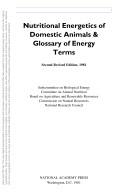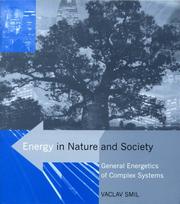| Listing 1 - 10 of 31 | << page >> |
Sort by
|
Book
ISBN: 1483222152 1483197123 1322340668 9781483197128 Year: 1967 Publisher: Amsterdam : Elsevier Publishing Company,
Abstract | Keywords | Export | Availability | Bookmark
 Loading...
Loading...Choose an application
- Reference Manager
- EndNote
- RefWorks (Direct export to RefWorks)
Bioenergetics
Bioenergetics --- Energy balance (Biology) --- Energy budget (Biology) --- Energy dynamics (Ecology) --- Energy utilization (Biology) --- Biochemistry --- Energy budget (Geophysics)

ISBN: 0309031273 9786610245987 1280245980 030959751X 0585149151 9780585149158 9780309031271 030907472X 9780309074728 Year: 1981 Publisher: Washington, D.C. National Academy Press
Abstract | Keywords | Export | Availability | Bookmark
 Loading...
Loading...Choose an application
- Reference Manager
- EndNote
- RefWorks (Direct export to RefWorks)
Animal nutrition. --- Animal nutrition --- Bioenergetics --- Energy balance (Biology) --- Energy budget (Biology) --- Energy dynamics (Ecology) --- Energy utilization (Biology) --- Animals --- Domestic animals --- Livestock --- Nutrition --- Biochemistry --- Energy budget (Geophysics)
Book
ISBN: 161122148X 9781611221480 9781617617881 1617617881 Year: 2011 Publisher: Hauppauge, N.Y. Nova Science Publishers
Abstract | Keywords | Export | Availability | Bookmark
 Loading...
Loading...Choose an application
- Reference Manager
- EndNote
- RefWorks (Direct export to RefWorks)
Bioenergetics. --- Energy metabolism. --- Bioenergetics --- Metabolism --- Microbial respiration --- Energy balance (Biology) --- Energy budget (Biology) --- Energy dynamics (Ecology) --- Energy utilization (Biology) --- Biochemistry --- Energy budget (Geophysics)
Book
ISBN: 9535152254 9535100904 Year: 2012 Publisher: IntechOpen
Abstract | Keywords | Export | Availability | Bookmark
 Loading...
Loading...Choose an application
- Reference Manager
- EndNote
- RefWorks (Direct export to RefWorks)
Cellular life depends upon energy storage, transformation, utilization, and exchange in order to optimally function and to stay-off death. The over 200-year-old study of how cells transform biological fuels into usable energy, a process broadly known as bioenergetics, has produced celebrated traditions in explaining origins of life, metabolism, ecological adaptation, homeostasis, biosynthesis, aging, disease, and numerous other life processes. InTech's edited volume, Bioenergetics, brings together some of these traditions for readers through a collection of chapters written by international authorities. Novice and expert will find this book bridges scientific revolutions in organismic biology, membrane physiology, and molecular biology to advance the discipline of bioenergetics toward solving contemporary and future problems in metabolic diseases, life transitions and longevity, and performance optimization.
Bioenergetics. --- Biochemistry. --- Biological chemistry --- Chemical composition of organisms --- Organisms --- Physiological chemistry --- Biology --- Chemistry --- Medical sciences --- Energy balance (Biology) --- Energy budget (Biology) --- Energy dynamics (Ecology) --- Energy utilization (Biology) --- Biochemistry --- Energy budget (Geophysics) --- Composition
Book
ISBN: 9780123884312 0123884314 1299619150 9781299619159 012388425X 9780123884251 Year: 2013 Publisher: Amsterdam, Netherlands : Elsevier,
Abstract | Keywords | Export | Availability | Bookmark
 Loading...
Loading...Choose an application
- Reference Manager
- EndNote
- RefWorks (Direct export to RefWorks)
Extensively revised, the fourth edition of this highly successful book takes into account the many newly determined protein structures that provide molecular insight into chemiosmotic energy transduction, as well as reviewing the explosive advances in 'mitochondrial physiology'-the role of the mitochondria in the life and death of the cell. Covering mitochondria, bacteria and chloroplasts, the fourth edition of Bioenergetics provides a clear and comprehensive account of the chemiosmotic theory and its many applications. The figures have been carefully designed to be me
Bioenergetics. --- Biological transport, Active. --- Active biological transport --- Active transport, Biological --- Energy dependent biological transport --- Uphill biological transport --- Energy metabolism --- Energy balance (Biology) --- Energy budget (Biology) --- Energy dynamics (Ecology) --- Energy utilization (Biology) --- Biochemistry --- Energy budget (Geophysics)
Book
ISBN: 9811645043 9811645051 Year: 2022 Publisher: Singapore : Springer,
Abstract | Keywords | Export | Availability | Bookmark
 Loading...
Loading...Choose an application
- Reference Manager
- EndNote
- RefWorks (Direct export to RefWorks)
Power resources. --- Bioenergetics. --- Environmental chemistry. --- Chemistry, Environmental --- Chemistry --- Ecology --- Energy balance (Biology) --- Energy budget (Biology) --- Energy dynamics (Ecology) --- Energy utilization (Biology) --- Biochemistry --- Energy budget (Geophysics) --- Energy --- Energy resources --- Power supply --- Natural resources --- Energy harvesting --- Energy industries
Book
ISBN: 9819905265 9819905257 Year: 2023 Publisher: Singapore : Springer Nature Singapore : Imprint: Springer,
Abstract | Keywords | Export | Availability | Bookmark
 Loading...
Loading...Choose an application
- Reference Manager
- EndNote
- RefWorks (Direct export to RefWorks)
This edited book focuses on agricultural and food waste biomass valorization in various fields such as energy and environment and the development of several other value-added products. The chapters in this book cover different areas like sources of agricultural and food wastes, recent trends on waste utilization, innovations and sustainability of techniques, and challenges associated with valorization of wastes. In the last few decades, scientists and researchers of different countries predicted that waste material generated due to global problems can be used as a potential feeding material for the manufacturing of different valuable products. Hence, there is a need for more research and development of several other value-added products from waste materials. Proper utilization of these waste materials has been discussed in this book. It also covers the bioactive recovery from food waste, health benefits of extracted bioactive, and utilization of valorized products. The book also explores future technological challenges and sustainability issues. This title is a great resource for environmental and chemical engineers, food scientists, food researchers and technologists, as well as for students and professionals working in this field.
Agriculture. --- Food science. --- Bioenergetics. --- Food Science. --- Energy balance (Biology) --- Energy budget (Biology) --- Energy dynamics (Ecology) --- Energy utilization (Biology) --- Biochemistry --- Energy budget (Geophysics) --- Food technology --- Chemical engineering --- Farming --- Husbandry --- Industrial arts --- Life sciences --- Food supply --- Land use, Rural

ISBN: 9780262195652 9780262693561 9780262297028 0262297027 1282100726 9781282100725 0262693569 0262195658 0262309580 9780262309585 9786612100727 6612100729 Year: 2008 Publisher: Cambridge, Mass. MIT
Abstract | Keywords | Export | Availability | Bookmark
 Loading...
Loading...Choose an application
- Reference Manager
- EndNote
- RefWorks (Direct export to RefWorks)
Energy in Nature and Society is a systematic and exhaustive analysis of all the major energy sources, storages, flows, and conversions that have shaped the evolution of the biosphere and civilization. Vaclav Smil uses fundamental unifying metrics (most notably for power density and energy intensity) to provide an integrated framework for analyzing all segments of energetics (the study of energy flows and their transformations). The book explores not only planetary energetics (such as solar radiation and geomorphic processes) and bioenergetics (photosynthesis, for example) but also human energetics (such as metabolism and thermoregulation), tracing them from hunter-gatherer and agricultural societies through modern-day industrial civilization. Included are chapters on heterotrophic conversions, traditional agriculture, preindustrial complexification, fossil fuels, fossil-fueled civilization, the energetics of food, and the implications of energetics for the environment. The book concludes with an examination of general patterns, trends, and socioeconomic considerations of energy use today, looking at correlations between energy and value, energy and the economy, energy and quality of life, and energy futures. Throughout the book, Smil chooses to emphasize the complexities and peculiarities of the real world, and the counterintuitive outcomes of many of its processes, over abstract models. Energy in Nature and Society provides a unique, comprehensive, single-volume analysis and reference source on all important energy matters, from natural to industrial energy flows, from fuels to food, from the Earth's formation to possible energy futures, and can serve as a text for courses in energy studies, global ecology, earth systems science, biology, and chemistry. Vaclav Smil is Distinguished Professor at the University of Manitoba and the author of many books, including Energy at the Crossroads (2003), The Earth's Biosphere: Evolution, Dynamics, and Change (2002), and Energies: An Illustrated Guide to the Biosphere and Civilization (1998), all of which are published by The MIT Press.
General ecology and biosociology --- Relation between energy and economics --- #SBIB:316.334.5U34 --- Sociologie van stad en platteland: milieuproblematiek --- Bioenergetics --- Energy budget (Geophysics) --- Budget, Energy (Geophysics) --- Geophysics --- Energy balance (Biology) --- Energy budget (Biology) --- Energy dynamics (Ecology) --- Energy utilization (Biology) --- Biochemistry --- Bioenergetics.
Book
ISBN: 9401787425 9401787417 1322043841 Year: 2014 Publisher: Dordrecht : Springer Netherlands : Imprint: Springer,
Abstract | Keywords | Export | Availability | Bookmark
 Loading...
Loading...Choose an application
- Reference Manager
- EndNote
- RefWorks (Direct export to RefWorks)
The fascinating machinery that life uses to harness energy is the focus of this volume of the Advances in Photosynthesis and Respiration Series. Experts in the field communicate their insights into the mechanisms that govern biological energy conversion from the atomic scale to the physiological integration within organisms. By leveraging the power of current structural techniques the authors reveal the inner workings of our biosphere.
Bioenergetics. --- Energy balance (Biology) --- Energy budget (Biology) --- Energy dynamics (Ecology) --- Energy utilization (Biology) --- Biochemistry --- Energy budget (Geophysics) --- Life sciences. --- Cell physiology. --- Biochemistry. --- Microbiology. --- Bacteriology. --- Life Sciences, general. --- Cell Physiology. --- Biochemistry, general. --- Protein Structure. --- Biological chemistry --- Chemical composition of organisms --- Organisms --- Physiological chemistry --- Biology --- Chemistry --- Medical sciences --- Cell function --- Cytology --- Physiology --- Biosciences --- Sciences, Life --- Science --- Microbiology --- Microbial biology --- Microorganisms --- Composition --- Proteins . --- Proteids --- Biomolecules --- Polypeptides --- Proteomics
Book
ISBN: 3642292496 364229250X Year: 2012 Publisher: Berlin ; New York : Springer,
Abstract | Keywords | Export | Availability | Bookmark
 Loading...
Loading...Choose an application
- Reference Manager
- EndNote
- RefWorks (Direct export to RefWorks)
Nanobioelectrochemistry covers the modern aspects of bioelectrochemistry, nanoscience and materials science. The combination of nanostructured materials and biological molecules enables the development of biodevices capable to detect specific substances. Furthermore, by using the bioelectrochemistry approach, the interaction between bio-systems and nanostructured materials can be studied at the molecular level, where several mechanisms of molecular behavior are elucidate from redox reactions. The combination of biological molecules and novel nanomaterials components is of great importance in the process of developing new nanoscale devices for future biological, medical and electronic applications. This book describes some of the different electrochemical techniques that can be used to study new strategies for patterning electrode surfaces with enzymes, organelles, cells and biomimetic systems. Also, it focuses on how enzymes and microorganisms can be used as biological catalysts in fuel cells for green power generation. By bringing together these different aspects of nanobioelectrochemistry, this book provides a valuable source of information for many students and scientists.
Electrochemistry. --- Nanochemistry. --- Human Anatomy & Physiology --- Chemistry --- Engineering & Applied Sciences --- Health & Biological Sciences --- Physical Sciences & Mathematics --- Physical & Theoretical Chemistry --- Technology - General --- Animal Biochemistry --- Nanotechnology. --- Bioenergetics. --- Chemistry. --- Biomaterials. --- Chemistry, Physical and theoretical --- Molecular technology --- Nanoscale technology --- High technology --- Energy balance (Biology) --- Energy budget (Biology) --- Energy dynamics (Ecology) --- Energy utilization (Biology) --- Biochemistry --- Energy budget (Geophysics)
| Listing 1 - 10 of 31 | << page >> |
Sort by
|

 Search
Search Feedback
Feedback About UniCat
About UniCat  Help
Help News
News